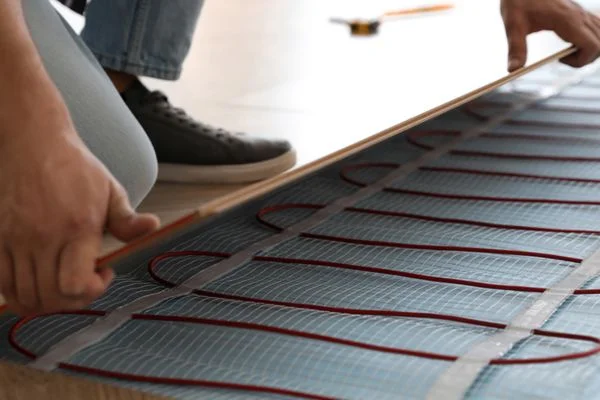Have you ever felt the cold ground beneath your feet in the winter? When you wake up feeling energized, it can be uncomfortable. Radiant floor heating, on the other hand, won’t leave your tiles or hardwoods cold. More and more people are using radiant floor heating to heat their homes. This efficient and cost-effective method keeps your space warm without increasing your energy bill. We will talk about how does a radiant floor heating system work and how they can benefit you.
Well in short, Radiant floor heating works by circulating warm water through pipes or heating cables beneath the floor, efficiently warming the space above. For more details continue to read.
How Does A Radiant Floor Heating System Work | Let’s Find Out
You install a network of pipes or electrical cables under your floor to get radiant floor heating. Heat is distributed evenly throughout your room, keeping you warm all the time.
Radiant heat transfers heat through radiation, not convection, so it’s much more comfortable without cold drafts like traditional heating systems. Radiant floor heating comes in two types: electric and water-based.
Radiant floor heating uses water heated by a boiler that flows through pipes in your house. You install these pipes above your insulation and underneath your floor covering, and they’re usually made of PEX (cross-linked polyethylene). Each room has a thermostat that regulates the temperature of the warm water circulating through the pipes.
Electric radiant floor heating systems use a series of cables underneath your floor to generate heat. A thin layer of mortar is applied over the wires embedded in thin mats.
A thermostat controls your room’s temperature. The heat is generated directly on the floor surface, so it responds faster than a water-based system.
Heating a room with water-based and electric radiant floor heating systems is very efficient because they don’t use much energy. Unlike other traditional heating methods, they don’t require ductwork, which can lose power. Further, since radiant floor heating is installed underneath your floor, it frees up wall space for furniture.
Low maintenance is another benefit of radiant floor heating. In contrast to boilers that need yearly inspections, it doesn’t need any maintenance once installed. Because radiant floor heating has no moving parts, it’s quiet and runs in the background.
Also Read: Can A Heated Towel Rail Replace A Radiator?
What Are The Disadvantages Of Radiant Heat?

Radiant heat is becoming increasingly popular as an energy-efficient and comfortable alternative to traditional heating systems. Tubes are installed underneath floors, ceilings, or walls to deliver heat.
Despite radiant heating’s many benefits, you should know its possible downsides before installing it. We’ll talk about the disadvantages of radiant heat now so you can decide if it’s right for you.
1. High Initial Cost
Its high initial cost is one of the most significant drawbacks of radiant heating. Installation costs can add up quickly with this heating system since it requires specialized tubing and equipment.
Additionally, installation is labor-intensive and often requires tearing up your floor or walls. Installation costs can range from a few thousand to tens of thousands of dollars, depending on your home.
Also Read: How Much Does A Radiant Floor Heating System Cost?
2. Slow Response Time
Radiant heat systems use heat waves to warm your home, which can take some time to spread through the house. Thus, it takes longer to reach the desired temperature than forced air. Radiant heating might not be the best option when you want your home to warm up fast.
3. Limited Cooling Effect
The limited cooling effect of radiant heating is another downside. The radiant heat in your home is excellent for keeping it warm but unsuitable for cooling it down. Consider a separate cooling system in areas where the temperature can get unbearably high.
4. Difficulty with Installation
Installing radiant heating systems in an existing house can be challenging, especially if you’re retrofitting. The tubing must be installed beneath your floor or ceiling, so you might have to take them down. Hiring a professional installer is the best way to ensure your installation is done right.
5. Potential for Leakages
The tubing of radiant heating can leak over time, despite it being an efficient heating method. These leaks can cause significant damage to your floor and subfloor if left unchecked, resulting in expensive repairs. Leaks can be detected and addressed early with regular maintenance and inspections.
Also Read: How Long Do Radiant Floor Heating Systems Last?
Bottom Line:
Now you know How Does A Radiant Floor Heating System Work. Radiant floor heating is an efficient, cost-effective, and low-maintenance way to keep your house warm.
Radiant floor heating has a lot of benefits, whether you’re building or renovating. Radiant floor heating systems are increasingly popular because of their even heat distribution, low energy consumption, and ease of maintenance.
Consider installing a radiant floor heating system to keep your feet warm and cozy this winter.



